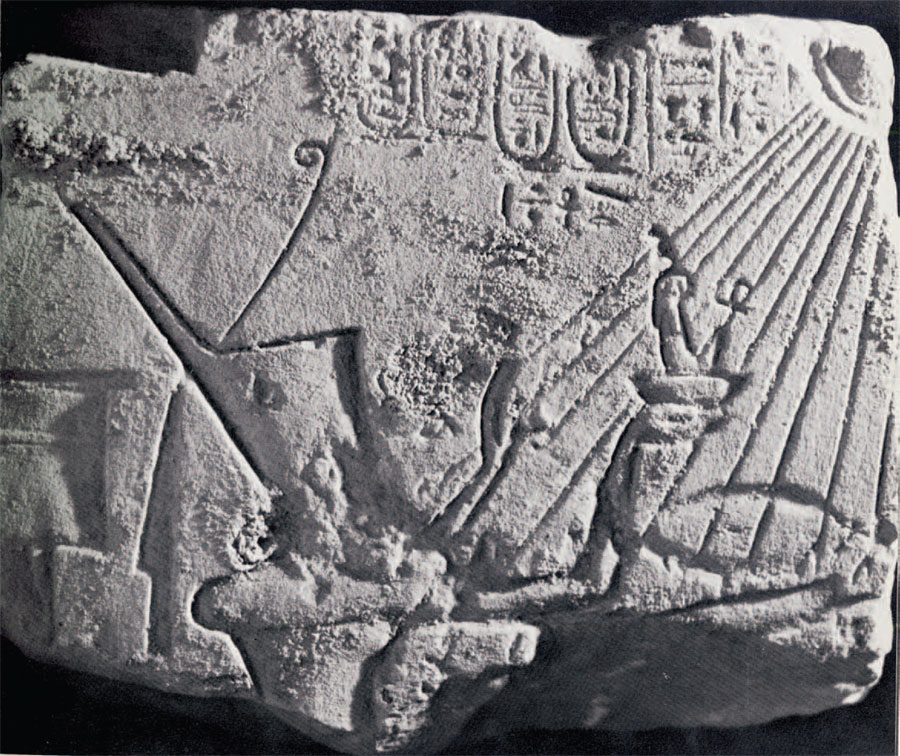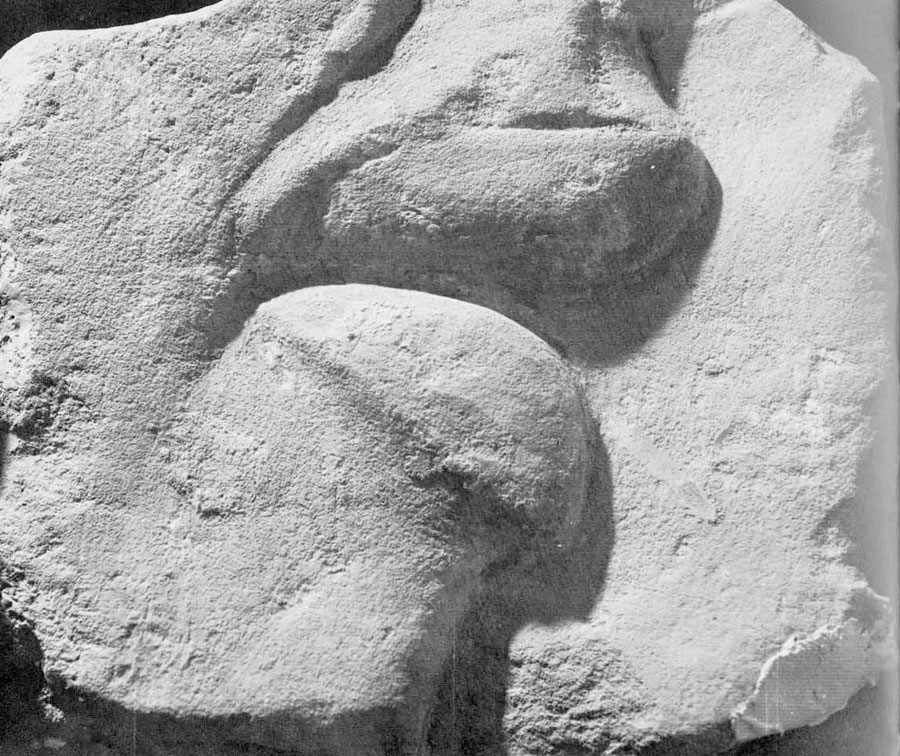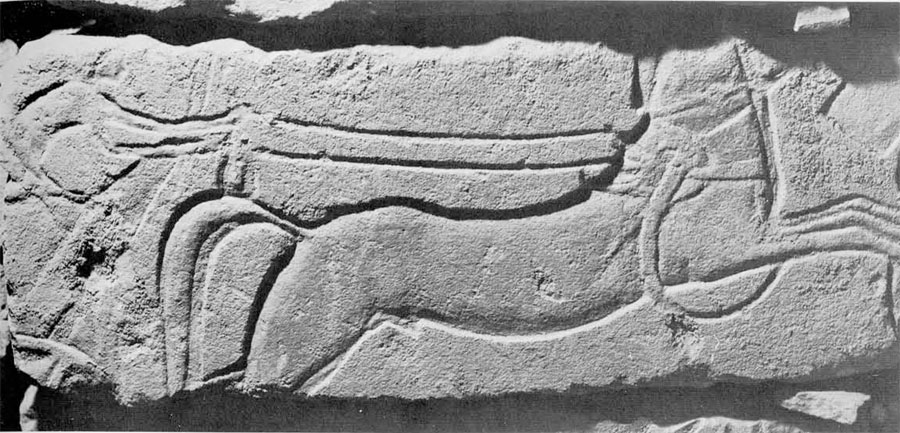Since October 1966, an expedition of the University Museum has been engaged in a study of polychrome relief-cut blocks from the Aten Temple built by Akhenaten at Thebes (modern Karnak) in the early years of his reign.
Akhenaten (1367-1350 B.C.) ruled an Egyptian empire, extending into Syria, Palestine and the Sudan which had been developed by his predecessors in the Eighteenth Dynasty and which gave Egypt a high degree of wealth and security. Akhenaten, however, seems primarily to have been interested in a religious “reform” by which the worship of the numerous gods of the Egyptian pantheon (dominated at this time by Amun, the god of empire) was replaced by an exclusive devotion to a deity represented by the sun-disc, the “Aten.”

Akhenaten at first governed from the ancient capital of Thebes and began important buildings in the area of Karnak, a great temple complex built and extended by his predecessors. Thebes’ close association with Amun and his priesthood caused Akhenaten however to transfer his capital to Tell el Amarna, a hitherto uninhabited site, in the sixth year of his reign, by which time he had changed his name from Amenhotep (which menas “Amun is satisfied” and expressed a devotion to Amun) to Akhenaten, “beneficial to the Aten.” Akhenaten thenceforth lived at Amarna, although retaining effective control of Egypt and continuing his building activities at Karnak. His devotion to religious affairs caused him to neglect growing rebellion in Western Asia, while the Egyptian priesthoods grew increasingly restive at the neglect and suppression of the gods they served. Akhenaten’s death was followed by a reaction and the restoration of the traditional pantheon and its worship.
Although virtually no trace of the Aten temple at Karnak was left at its site when the temple was dismantled after Akhenaten’s death, in the fourteenth century B.C., large-scale reuse of the blocks in subsequent buildings has resulted in recapture of many thousands of them during numerous archaeological repair projects at Karnak over the last sixty years.
During this period, more than 25,000 decorated blocks have been removed from monuments in the vicinity of Karnak, and a possibly equal number of undecorated blocks were recovered, but most of the latter were considered unimportant and were reinserted invisibly at various points during the repair and restoration work.

The largest number of these blocks found in one place came from the great Hypostyle Hall at Karnak, in which the enormous columns were all built originally on foundations of Akhenaten Temple blocks. Subsiding of these columns, as a result of the recurrent high ground water, necessitated replacement of the blocks with more substantial foundations. Likewise, extensive repairs to the second pylon revealed that the interior spaces of both wings had been stuffed in antiquity with Akhenaten blocks. Additional blocks in large numbers are known to await recovery, particularly in the ninth and second pylons.
All of the blocks are uniform in size (2 feet wide, 10 inches high) and are of sandstone, probably from the ancient quarry at Silsileh, to judge by an inscription still preserved at that source. A few limestone blocks and a few blocks of later date are intermingled with the sandstone blocks in the storehouses where they are now stacked, but their provenance is not certain.
For many years Egyptologists have dreamed of a scientific study of this material, but its unprecedented size and scope have seemed to defy accomplishment. Now, however, the Department of Antiquities in Cairo has contracted with the University Museum, and the work has begun, under a generous grant of counterpart funds from the Smithsonian Institution.
It seemed clear from the outset that no undertaking of this size and complexity could be accomplished in an acceptably limited period by traditional methods, and it was decided to support the efforts of scholars with electronic aids. Under an arrangement with International Business Machines Corporation, the use of their equipment already in Egypt has been provided.

The program of this project begins with black-and-white photography of the individual blocks. After the photography has been completed, further elements of the program are carried out in the project’s headquarters at 15 Midan el-Tahrir in Cairo. The staff initially records a well-nigh infinite amount of descriptive detail for each block on special coding sheets.
The coded information includes colors, which are manually recorded on cards when the black-and-white photographs are taken. Also coded are types and sizes of human figures and objects, cut-offs (top and bottom), angles of sun rays, details of hieroglyph inscriptions, types of represented scenes, architectural clues, details of deliberate defacements, and many other particulars. Fortunately, a virtually unlimited amount of information can be condensed into the eighty columns of the IBM punch card.
After the punch cards have been prepared, IBM provides us with lists of stones, broken down into an almost infinite number of combinations of categories. These will serve the next project phase, which involves piecing together the elements of this unprecedented jigsaw puzzle. Unfortunately the stones, with rare exceptions, have become completely disarranged from their original juxtapositions in the temple.
Let us suppose that the piecing together begins with a certain stone showing a portion of a kneeling figure placed on a horizontal register line at the left, the right side of a cartouche with his name, and a portion of an offering tabler also at the left. If it were necessary to search through tens of thousands of photographs to find the adjoining stone to the left, and repeat the process tens of thousands of times to complete the matching, the end of the project would never be reached.

In this hypothetical case the adjoining stone to the left would be immediately found, or its absence established, by consulting the IBM lists in search of a stone with the corresponding details at its right hand end. The number of blocks possibly qualifying would be so small that their photographs could be quickly examined. All of this matching can be accomplished in a matter of months by this method.
When the matching stage is completed, and the appearance of the walls of this temple can be visualized, the real study can begin. We can already perceive that our project will encompass several distinct aspects of scholarship. Perhaps the most significant will be the role of this building in the history or art, at a period when the Egyptian artist and sculptor was taking off on new creative departures. Hardly less important are the other necessary analyses: (1) consideration of the place of the temple in the history of religion, when Akhenaten was briefly revolutionizing his country’s religious beliefs; (2) the structural details of the building, and its place in the panorama of ancient Egyptian architecture; and (3) the history of the period, on which the great number of hieroglyphic inscriptions will throw light.
To accomplish these objectives and to prepare the project’s final extensive publication, a high degree and depth of scholarship will be required. To measure up to this necessity, the University Museum has mustered a group of consultants, who will be increasingly active as the project develops. Professor John Wilson of the Oriental Institute, Chicago, has already been in Egypt and has given invaluable assistance in many ways. John D. Cooney, of the Cleveland Museum, will contribute his expertise, including his deep study of the parallel blocks from Hermopolis. Dr. H. Ricke, Director of the Swiss Archaeological Institute in Cairo, has already begun his study of the architectural aspects of our temple. Dr. George R. Hughes of the Oriental Institute will contribute his knowledge of the blocks, enhanced by his years of residence at Chicago House in Luxor. It is hoped that Professor William Kelly Simpson of Yale will serve on a later Editorial Review Board. Continuous advice has been provided by Dr. Charles F. Nims, Director of Chicago House, who has accepted an assignment as Resident Egyptologist. Numerous scholars in Egypt have been cooperative, and the officials of the Department of Antiquities in Cairo have furthered our activities in many ways.
As of September, 1967, the staff in Cairo has coded nearly all of the approximately 16,000 blocks in a storehouse built several years ago along the west wall of the Khonsu Temple at Karnak.

It is known that numerous Akhenaten Temple blocks were removed from the ninth pylon at Karnak many years ago. These probably are among the blocks we have photographed in the storehouses. Meanwhile, further blocks are being taken from this pylon. We have photographed a number of these. Additional blocks are still in the west wing of the pylon, and presumably many thousand are in the east wing, awaiting recovery. Also, the recovery of the Akhenaten blocks from the second pylon years ago was not complete, so that some thousands probably still remain there.
The question immediately comes to mind: how do we identify a block as coming from this temple? In most cases, the Akhenaten style is unmistakable, and no other building of this period is known to have been at Karnak, from which such blocks might have come. It seems clear that this temple is the only monument built in ancient Egypt with sandstone blocks of this unusual small size. Actually, we are not certain that there was only one building constructed of these blocks as there may have been several buildings in this temple complex. We are proceeding on the assumption that there was only one, but the question must remain open until all evidence has been considered.
As we have IMB lists on only 4,000 blocks, it has not been advisable to begin matching them. However, we already have acquired considerable information on the monument. The original building must have been of immense size. It is possible to estimate that approximately 55,000 blocks will be counted at various points around Luxor. This would represent a solid area of wall space totaling almost 8,000 square meters and the temple must have been even larger than this figure indicates, since the known stones almost certainly do not represent one hundred percent of the blocks which formed its decorated walls. Before the completion of our work, we are confident that we will have information from our electronic aids to permit a good estimate of the total number of blocks, and thus of the size of the temple.
Another clarification already with us is with regard to the so-called “Amarna style” in Egyptian art. This term is commonly applied to the unusual treatment, particularly that given to the human body and facial features, by the artists of this period, and the general departure from traditional rigidity and conformity of Egyptian art. Our superficial examination of these blocks has already revealed that the style in question was already in full bloom in the construction of our temple, before Akhenaten moved his capital to Amarna, probably even before he decided to do so.

We have not yet determined the meaning of a considerable number of blocks which contrast sharply with the majority. They have a solid white background on which all color details have been superimposed. The style of art on these blocks corresponds generally to that of the majority, although there are clear distinctions in scale and in minor respects. It has been noted that virtually all of the blocks now coming from the ninth pylon are of the “white” type. Conceivably, they formed a discrete portion of the temple, or even a separate building.
We are clear about the general nature of the scenes depicted in this Aten temple. Understandably they are predominantly religious, with uncounted hundreds of scenes developed under the sun-disc and its diverging rays terminating in human hands. We have been surprised by the small number of scenes of subjects from nature, and by the virtual, if not complete, absences of battle scenes. There are a great many jubilee scenes, and chariots abound.
A few mammoth figures were carved on the walls of this temple, one or more apparently rising, with crown and Aten disc above, to a height of thirty feet or more from the floor. A great many deliberate defacements and obliterations were carried out before the temple’s dismantling. Queen Nefertiti‘s face is frequently obliterated.
The name of the king appearing in many cartouches is indicative. In some cases it shows as Amenhotep, frequently changed by overcutting into Akhenaten, and in a few instances it was originally cut as Akhenaten. This shows that his change of name occurred after the beginning of the wall sculpture and before its completion. Further research on this may permit interesting deductions on the precise time of the change of the chronological development of Akhenaten’s theology.

The oldest of the royal princesses, Meritaten, is depicted many times. The second daughter, Mekataten, is shown or mentioned only rarely, and we have found no trace of the younger princesses. This will also, with further study, lead to important conclusions. An important stone attests to the fact that Akhenaten married, during Nefertiti’s lifetime, one of her daughters, and elevated the child to the status of queen.
The interest in this project is heightened by the fact that none of the numerous temples erected by Akhenaten has survived. The volume alone of the potential information about the period which can be derived from these blocks will greatly enlarge our knowledge of Akhenaten, and of his period.
Great credit is due our Cairo staff for the dedicated and competent manner in which they are performing. Most of these young Egyptians are graduate Egyptologists, including the senior member, Dr. Tawfik Ahmed. The work they are doing in coding the stones is most arduous, and requires great concentration, accuracy, and knowledge of the subject. The requirements of accuracy are so stringent that all data must be double-checked at each of the numerous successive stages of the work to forestall unusable inaccurate data. The use of electronic equipment makes it possible to record and use not only facts that are certain, but doubtful information as well, without compromising the validity of the end results. An example will illustrate the point. Some of the stones show straight lines which may or may not be sun rays. They are all coded as such, but those which have an uncertain identification are coded separately as doubtful. Thus the lists can differentiate between stones which are surely parts of Aten disc scenes and those which may only possibly represent such scenes. In this way, statistics on many features of the stones can be expressed in minimum and maximum terms.
The electronic aids will serve initially mainly in matching the blocks. Later, however, they will be used in much more sophisticated ways. Their ability to perform the most complicated mathematical computations in a flash, and to produce endless statistical data, will enable us to reach deeply into the circumstances lying behind the blocks themselves. We need to know, for example, all that can be determined about the number and types of scenes in the temple, the floor plan, the nature and chronology of the temple dismantling, the size of the temple and the total number of blocks in it, the data of defacements and obliterations, as well as the manner in which they were carried out, and a great many more facts.

The amount of data available to us is so vast that there is unlikelihood of purely statistical bias. If, therefore, the machines reveal to us the interesting facts that there are only 2.7% as many king’s heads on our stones as there are king’s bodies, whereas the area of a king’s head is 5.9% that of a king’s body, we would have to conclude that there was systematic and deliberate discarding of stones showing king’s heads. The reasons for this would be well worth study.
The use of these aids, which is not for the purpose of replacing the scholar but of freeing him from time-consuming drudgery better performed by the machine in a fraction of the time he would require, can give him more time in which to apply his specialized mind to intellectual activity worthy of his high competence. This use thus illustrates the general principle that when the human mind is faced with the task of organizing more data than it has the time to digest, it must turn to these aids lest important tasks remain unfulfilled. We are rapidly entering this new computer age.
